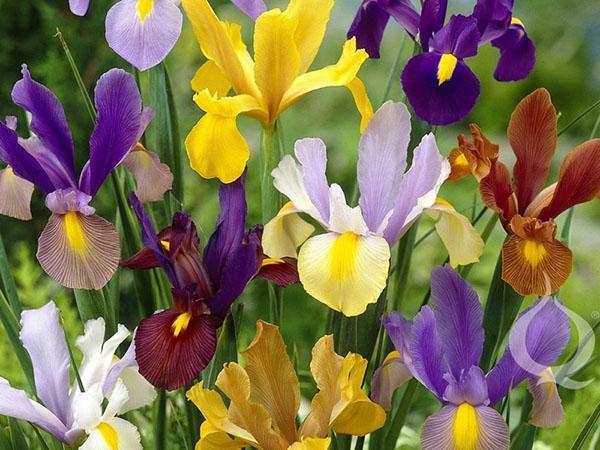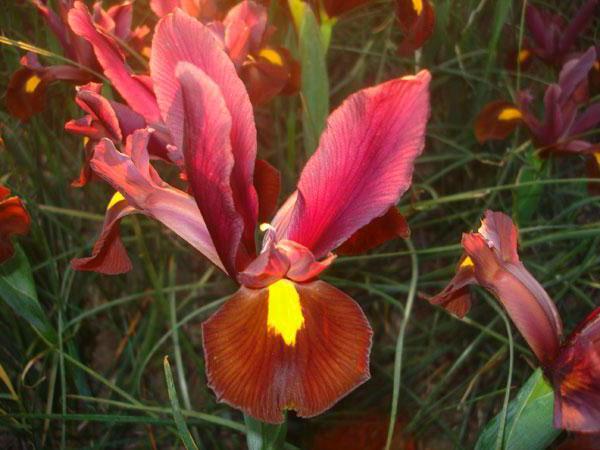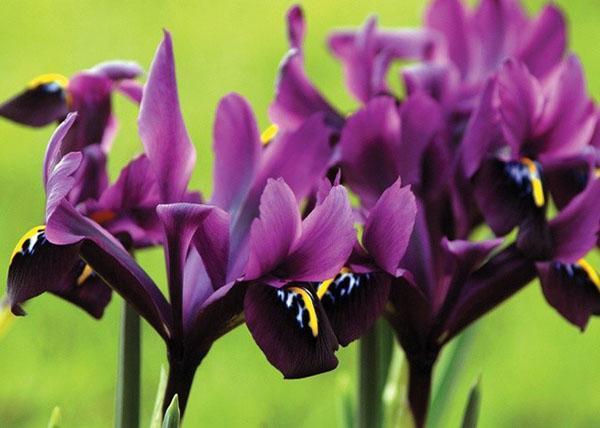Planting and caring for the fabulous Dutch bulbous iris
 One of the most beautiful and most romantic plants is the Dutch bulbous iris. Planting and caring for it is a bit of a hassle, but it will more than pay off with a beautiful blooming flower bed. Outwardly, it is somewhat reminiscent of a tropical butterfly perched on a stalk in order to rest and fly further around the world. Thanks to its beauty, iris instantly won over gardeners. Almost no flower bed can do without it.
One of the most beautiful and most romantic plants is the Dutch bulbous iris. Planting and caring for it is a bit of a hassle, but it will more than pay off with a beautiful blooming flower bed. Outwardly, it is somewhat reminiscent of a tropical butterfly perched on a stalk in order to rest and fly further around the world. Thanks to its beauty, iris instantly won over gardeners. Almost no flower bed can do without it.
Description and varieties

To begin with, let's move away from the topic and mention that thermophilic irises have three main varieties:
- Juno... They are characterized as heat-loving plants. Basically, they are grown as annuals.
- Iridodictiums (they are also called netted, for example, the iris of the Dutch Ash Jam). The most unpretentious and undemanding. They bloom immediately after the snow melts.
- Xyphyums... This variety, in turn, has its own categories: Spanish, American and Dutch. This variety is the most common in our area, so they are the subject of discussion. Lovers grow them as annuals or indoor flowers. You can determine the belonging to the species by the presence of thick scales on the bulbs, which, after flowering, should be dug up, dried and sent to a cold place for the winter.

Iris Dutch is a ksifium, and belongs to the hybrid varieties of the Dutch category, bred in the country of the same name. In flower shops, they are sold in the form of bulbs covered with multiple layers of scales. In adult form, the plant height is on average 0.6 m, but it all depends on the variety. For example, the iris of the Dutch Blue Diamond, Casablanca, Blue Magic and others varies in height within 0.45-0.7 m.
If you plant irises in places inaccessible to the wind, they will not need supports.
The plant itself is winter-hardy. Nevertheless, in severe frosts, they need to be covered with something in order to prevent freezing. Irises found wide application. They are not only used to decorate flower beds and flower beds, but also grown under the cut to create bouquets and flower arrangements.
 The Dutch iris bloom (photo below) begins in the last week of May and lasts until early June. As for the range of shades of buds, they can be very diverse, starting from white and blue and ending with orange and purple. After flowering, the plant begins to dry the foliage, and by the end of August it dries up completely.
The Dutch iris bloom (photo below) begins in the last week of May and lasts until early June. As for the range of shades of buds, they can be very diverse, starting from white and blue and ending with orange and purple. After flowering, the plant begins to dry the foliage, and by the end of August it dries up completely.
Iris Dutch bulbous: planting
 In principle, the planting of bulbous irises is identical to root irises. But still, there are a number of nuances that must be strictly followed:
In principle, the planting of bulbous irises is identical to root irises. But still, there are a number of nuances that must be strictly followed:
- The growing season of bulbous irises is rather short. Flowering occurs late, near summer, and stops quickly. Therefore, it is important to choose the right material for planting. In this case, you should pay attention to the golden color of the bulbs, the absence of dark spots or soft areas. The development of the plant and its condition depend on the correct choice.
- Before planting the flower bulb, it is imperative that it be dipped in a fungicide solution and kept there for several hours. This procedure protects it from rotting in the ground. After the matured onion is thoroughly dried.
- The bulbous Dutch iris is being planted in spring.
- The land in the flowerbed or in the place where the irises will be planted should be plowed in advance, and then disinfected with potassium permanganate (just water it.). This will help get rid of germs, bacteria that can harm the bulb and destroy the plant.
- The bulbs are planted when roots begin to appear. At the same time, they are planted to a depth of 10-15 cm, keeping a distance between the specimens of 15 cm. Such a distance will ensure good development and growth of the plant and will not allow shading each other in a group with each other.
- The planted bulbs are sprinkled with soil and watered well.
Basic rules for caring for bulbous Dutch iris
 In order for the plant to develop without complications and to please with flowering for a long time, a number of rules for caring for flowers should be observed.
In order for the plant to develop without complications and to please with flowering for a long time, a number of rules for caring for flowers should be observed.
Lighting
Irises are light-loving plants, so you need to choose dry and well-lit places for planting. But at the same time, they must be protected from direct sunlight. An ideal place for a partial shade flower bed with sufficient illumination.
The soil
As for the substrate, nutritious and loose soil is important for irises. Moreover, its pH must be alkaline or neutral. If the indicators differ or a clay substrate predominates on the site, then the addition of sand will help to correct the situation, which prevents stagnation of water, as well as the introduction of slaked lime to adjust the pH to the required value.
Irises prefer loose soil, so loosening should be done regularly after planting. 1-2 times / week will be enough.
Watering
Since irises are very sensitive to waterlogging of the soil (this leads to decay of the roots and further death of the entire bulb), before planting, you need to take care of good drainage so that water can "leave" and not accumulate at the planting site.
Russia is characterized by rainy seasons, therefore, after flowering, the bulbs are recommended to be dug, dried and placed in a dry storage place.
Top dressing
 Also, the plant does not tolerate exposure to any chemicals. Therefore, you need to be very careful with feeding. Better stop the choice on compost or humus, in the amount of 1 bucket / m 2... After planting the bulbs, the plants can be “fed” with wood ash.
Also, the plant does not tolerate exposure to any chemicals. Therefore, you need to be very careful with feeding. Better stop the choice on compost or humus, in the amount of 1 bucket / m 2... After planting the bulbs, the plants can be “fed” with wood ash.
Often in stores sell iris Dutch mix. Planting and caring for these bulbs is identical. Only the color of the buds will be a "surprise" for you.
Now you know how and when to plant Dutch irises. Compliance with all the rules will allow you to grow plants of amazing beauty and enliven your site with bright colors.
In the text they write what to plant in the spring, and in the video - in the fall. Are you talking about different colors?
Planting is possible both in autumn and spring.